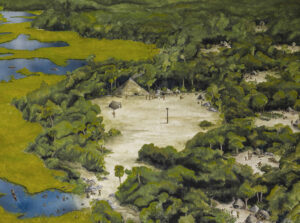COMMITTED TO SCHOLARLY RESEARCH, EDUCATION, AND PUBLIC OUTREACH
The goal of the University of North Florida (UNF) Archaeology Lab is to enrich our knowledge and understanding of the archaeology of northeastern Florida and surrounding areas. As part of the Department of Sociology, Anthropology, and Social Work, the Archaeology Lab offers challenging learning and faculty-directed research opportunities for UNF students. The laboratory provides students with hands-on experience in both archaeological fieldwork and laboratory analysis. Field and laboratory settings blend academic teaching with research-oriented objectives that benefit both faculty and students. The UNF Archaeology Lab is currently involved in four somewhat interrelated research projects that together cover the period A.D. 900-1700.
Just as important as scholarly research is our commitment to public education. The public deserves to know the colorful and vibrant story of the Indigenous peoples who thrived in communities that now lay beneath their feet. Archaeological research over the past decade has challenged conventional thinking on Native American culture in northeastern Florida and altered the way we interpret many aspects of their way of life. Unfortunately, little of this new archaeological information has reached the public and a part of the Archaeology Lab's mission is to educate and broaden this knowledge.
THE SARABAY PROJECT
The UNF Archaeology Lab is undertaking one of the most intensive and extensive excavations at a Timucua village in the state of Florida, through the implementation of a 4-year field project. During 2020-2023 field seasons, UNF conducted archaeological excavations at the Armellino site on Big Talbot Island. UNF also excavated broad areas in search of activity areas, houses, and other buildings associated with the village of Sarabay. The project provides a solid database for sixteenth-century Timucua settlements and allow students and volunteers the opportunity to touch the ancient past of northeastern Florida.
Learn more about the Sarabay Project
INDIGENOUS FLORIDA: A DIGITAL HUMANITIES PARTNERSHIP
Launched in May 2023, this digital humanities site is a partnership between Dr. Denise I. Bossy, Dr. Keith Ashley, and students at the University of North Florida. Amarilys Sánchez, M.A. helped to develop much of the site. This project tells a new Indigenous-centered history of present-day Jacksonville, one that more accurately includes the perspectives of the Mocamas, Guales, Yamasees, and their ancestors. Their homelands encompassed much of Northeast Florida. Using tours, exhibits, objects, images, and maps, this site makes our research open to everyone. Our first project is an Indigenous digital walking tour of Fort Caroline in present-day Jacksonville. In the coming months and years, we will continue to add new tours and exhibits.
Visit the Indigenous Florida website
THE SCIENCE OF...
focuses on science and nature in Northeast Florida.
From Jacksonville to Cahokia... Archaeology unearths Native American trading networks.
Did you know that Cahokia was the largest population density north of Mexico until Philadelphia in the 1800s? And that trading reached far and wide, all the way to the Mill Cove complex in what is now now Jacksonville Florida? Join Dr. Keith Ashley, University of North Florida assistant professor of archaeology as he shares recent findings unearthed from Northeast Florida in a fascinating tale that can only be told through the intersections of meticulous digging, chemical and physical analyses, history, and collaborative top-notch sleuthing.


